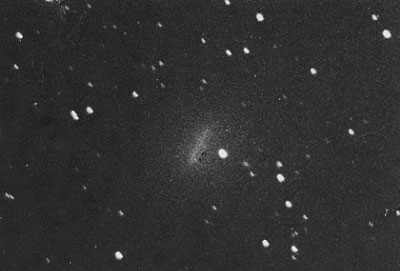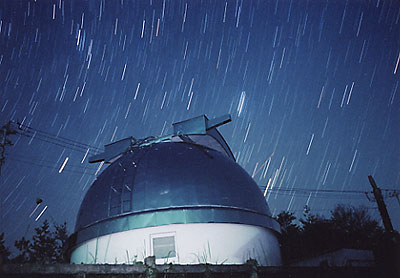177P/Barnard 2 and 73P/Schwassmann-Wachmann 3
The following are the observations of 177P/Barnard 2:
177P/Barnard 2
2006UT RA (2000.0) Dec. m1
July 28.52847 16 56 10.52 +23 52 53.7 9.5 T 372
28.53403 16 56 10.24 +23 53 22.4 372
The sky cleared up completely and I didn't have to worry
about clouds at all throughout the night. Transparency was also excellent.
I observed Barnard 2 with the 20cm refractor at 60x as usual.
It was a very large glow that appeared to extend as far as 10'. The degree
of condensation was 1-2 visually, while in photographs the nucleus was
visible at about 15th magnitude at the center. With the nucleus being stellar,
the measurement of the positions is easy. The photographic magnitude of
the nucleus and coma combined will be 12th or 13th. However, the magnitude
visually estimated will give a quite different value. If the coma extends
as far as 10', the total magnitude will be extremely bright.

The glow of Barnard 2
The coma is quite extensive.
19-minute exposure from 21:54, July 28, 2006, J.S.T.
60cm f/3.5 reflector, TMY400 film

73P/Schwassmann-Wachmann 3
10-minute exposure from 3:35, July 29, 2006, J.S.T.
60cm f/3.5 reflector, TMY400 film
I continued photographic observation until 2 am and then
began sweeping the pre-dawn sky. Around this time of 1955 Mr. Minoru Honda
discovered an 8th-magnitude comet. It was in Eridanus near Orion when discovered
and moved north reaching 5th magnitude. While recalling this event, I set
up the digital setting circles. However, the digital readings were completely
wrong, perhaps because the telescope was not precisely aligned. I struggled
on, but in the end threw up my hands. I gave up on the setting circles
thinking it would be better to use a star chart if I discovered a comet.
I continued to search the eastern sky for about 40 minutes.
Clusters around Auriga and Perseus are exceptionally pretty.
This sort of experience keeps me searching even without a success. A little
later, M33 in Triangulum suddenly entered the field of view. Its brightness
surprised me. It should be around 6th magnitude and visible to the naked
eye. I remembered that Barnard 2, which I had observed a little earlier,
looked like M33 with a coma almost as large as this. I searched the eastern
sky by dividing it into three horizontal bands and swept each band vertically
perpendicular to the horizon. The two most important factors for comet
search are a wide field of view and sharp focusing in the telescope. There
is nothing more satisfactory than completing the night's searching.
I may have a chance to come across a new comet some day...Holding
a glimmer of hope for finding a comet I continue to search . I spent 8
hours from the time I had arrived at the observatory. This terrible heat
tested my physical strength to the limit. I left the observatory for home
with a half hour still remaining before the daybreak. Brilliant Subaru
(the Pleiades) was shining over the dome and so was good old Orion. I looked
back at the twilight sky many times feeling a tinge of regret.

Subaru (the Pleiades) over the observatory
3am on July 29, 2006



